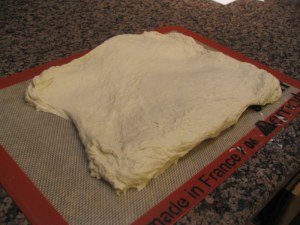
With this post, I finally join as a blogger the crowd of bakers who are taking “The Challenge“. You can see the other breads, made before this blog was launched, by clicking here.
Ciabatta is one of my favorite kinds of bread. A friend of mine (you know who you are…) says she does not understand this fascination with holes in the bread, as obviously where there is a hole, there is NO bread. What can I say? I love the texture, the look, the “feel” of a bread invaded by holes…
I have made ciabatta in the past, but never this particular recipe. Peter Reinhart gives us a choice, ciabatta made with “poolish” or “biga”. No need to panic, those are simple terms used by bakers, that define a pre-mixture of yeast with water and flour. In very general terms, a “poolish” contains more water, ends up looking like porridge. “Biga” is thicker, resembles play dough. Either of these are incorporated in the final dough, sometimes more yeast might be added to it. For this bread, I decided to use a “poolish”.
The “poolish” is added to flour and more yeast in the bowl of a stand mixer.

After mixing, the dough is spread in a rectangular shape and folded twice during a few hours of rising. You can see how a dough is folded by clicking here.

After the first fold, things start to get really smooth, but the second fold is what really changes the look of the dough. Notice the nice “bubbly” nature…

More rising, the dough is cut in pieces, and allowed to rise some more in improvised “couches”


Ready to go into the oven!

